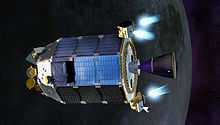Ranger 4
 Ranger 4 | |
| Mission type | Lunar impactor |
|---|---|
| Operator | NASA |
| Harvard designation | 1962 Mu 1 |
| SATCAT № | 280 |
| Mission duration |
10 hours (operational) 64 hours (to impact) |
| Spacecraft properties | |
| Manufacturer | Jet Propulsion Laboratory |
| Launch mass | 331.1 kilograms (730 lb) |
| Start of mission | |
| Launch date | April 23, 1962, 20:50:00 UTC |
| Rocket | Atlas LV-3 Agena-B |
| Launch site | Cape Canaveral LC-12 |
| Lunar impactor | |
| Impact date |
April 26, 1962, 12:49:53 UTC Failed before impact |
| Impact site | 15°30′S 130°42′W / 15.5°S 130.7°W |
Ranger 4 was a spacecraft of the Ranger program designed to transmit pictures of the lunar surface to Earth stations during a period of 10 minutes of flight prior to crashing upon the Moon, to rough-land a seismometer capsule on the Moon, to collect gamma-ray data in flight, to study radar reflectivity of the lunar surface, and to continue testing of the Ranger program for development of lunar and interplanetary spacecraft. An onboard computer failure caused failure of the deployment of the solar panels and navigation systems; as a result the spacecraft crashed on the far side of the Moon without returning any scientific data. It was the first U.S. spacecraft to reach another celestial body.[1]
Spacecraft design
Ranger 4 was a Block II Ranger spacecraft virtually identical to Ranger 3. The basic vehicle was 331 kg (730 lb) 3.1 m (10 ft) high and consisted of a lunar capsule covered with a balsawood impact-limiter, 650 mm (26 in) in diameter, a mono-propellant mid-course motor, a 5080 lbf (22.6 kN) thrust retrorocket, and a gold- and chrome-plated hexagonal base 1.5 m in diameter. A large high-gain dish antenna was attached to the base. Two wing-like solar panels (5.2 m across) were attached to the base and deployed early in the flight. Power was generated by 8680 solar cells contained in the solar panels which charged an 11.5 kg 1 kWh capacity AgZn launching and backup battery. Spacecraft control was provided by a solid-state computer and sequencer and an earth-controlled command system. Attitude control was provided by Sun and Earth sensors, gyroscopes, and pitch and roll jets. The telemetry system aboard the spacecraft consisted of two 960 MHz transmitters, one at 3 W power output and the other at 50 mW power output, the high-gain antenna, and an omni-directional antenna. White paint, gold and chrome plating, and a silvered plastic sheet encasing the retrorocket furnished thermal control.[1]
The experimental apparatus included: (1) a vidicon television camera, which employed a scan mechanism that yielded one complete frame in 10 s; (2) a gamma-ray spectrometer mounted on a 1.8 m boom; (3) a radar altimeter; and (4) a seismometer to be rough-landed on the lunar surface. The seismometer was encased in the lunar capsule along with an amplifier, a 50-milliwatt transmitter, voltage control, a turnstile antenna, and 6 silver-cadmium batteries capable of operating the lunar capsule transmitter for 30 days, all designed to land on the Moon at 130 to 160 km/h (80 to 100 mph). The radar altimeter would be used for reflectivity studies, but was also designed to initiate capsule separation and ignite the retro-rocket.[1]
Mission
The mission was designed to be boosted towards the Moon by an Atlas/Agena, undergo one mid-course correction, and impact the lunar surface. At the appropriate altitude, the capsule was to separate and the retrorockets ignite to cushion the landing. Due to an apparent failure of a timer in the spacecraft's central computer and sequencer following launch, the command signals for the extension of the solar panels and the operation of the Sun and Earth acquisition system were never given. The instrumentation ceased operation after about 10 hours of flight. The spacecraft was tracked by the battery-powered 50 milliwatt transmitter in the lunar landing capsule. Ranger 4 impacted the far side of the Moon (229.3 degrees E, 15.5 degrees S) at 9600 km/hr at 12:49:53 UT on April 26, 1962 after 64 hours of flight.[1]
This spacecraft, similar in design to Ranger 3, was the first U.S. spacecraft to reach another celestial body. Although the spacecraft did not achieve its primary objective, the Atlas-Agena-Ranger combination performed without fault for the first time.
Footnotes
See also
References
- "National Space Science Data Center - Ranger 4". National Air and Space Administration. Retrieved 19 June 2012.
External links
- Lunar impact: A history of Project Ranger (PDF) 1977
- Reuters.com, Planned lunar missions
- Reuters.com, Chronology - Five key dates in the race to the moon
| |||||||||||||||||||||||||||||||||||||||||||||||||||||||||||||||||||||||||
| ||||||||||


